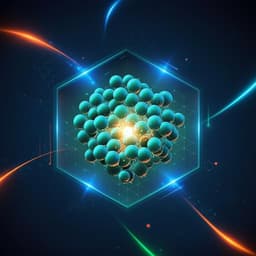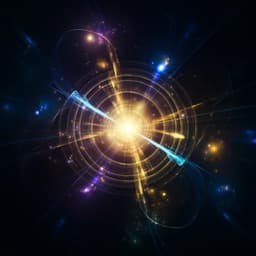
Physics
A quantum coherent spin in hexagonal boron nitride at ambient conditions
H. L. Stern, C. M. Gilardoni, et al.
Discover groundbreaking research conducted by Hannah L. Stern and colleagues on quantum coherent control of a single-photon-emitting defect spin in hBN. This innovative work reveals how decoupling protocols can extend spin coherence, paving the way for advanced room-temperature spin qubits for quantum computing applications.
~3 min • Beginner • English
Introduction
The study addresses the need for solid-state spin–photon interfaces that operate at room temperature with long-lived spin coherence and efficient optical access—key for quantum repeaters, networks, and sensing. Existing platforms (diamond, silicon carbide) have demonstrated room-temperature coherent spins but often suffer from challenging optical properties. Layered materials, especially hexagonal boron nitride (hBN), offer advantages for scalable growth, deterministic defect creation, and integration. Prior work in hBN showed ensemble-level spin signatures attributed to boron vacancies with poor optical efficiency and single visible emitters with ODMR only under applied magnetic fields, suggesting either weakly split S=1 triplets or S=1/2 systems. The research question is whether an individually addressable single-photon-emitting defect in hBN can host a quantum-coherent electronic spin with a well-defined ground-state manifold accessible at room temperature and zero magnetic field, and what the microscopic spin and hyperfine characteristics are.
Literature Review
Previous efforts have focused on optically interfaced solid-state spins in diamond and SiC, with demonstrations of single-spin coherence at room temperature but with optical challenges. In hBN, ensembles of boron vacancies (V_B) showed spin initialization/manipulation but only on ensemble level due to low quantum efficiency; visible-spectrum defects (~600 nm) yield bright single-photon emission with high zero-phonon-line fractions, yet prior single-defect ODMR signals appeared only with finite magnetic fields, implying either S=1/2 spins or S=1 triplets with low zero-field splitting. Earlier studies on similar MOVPE-grown hBN with carbon incorporation identified spin resonances attributed to S>1/2 systems with low ZFS under applied fields. There is active theoretical work proposing carbon clusters (trimers, tetramers) and vacancy–substituent complexes as possible quantum emitters in hBN, but predictions of S=1 with ~2 GHz ZFS remain limited, motivating experimental clarification.
Methodology
Materials preparation: Multilayer hBN (~30 nm) was grown by metal-organic vapour phase epitaxy (MOVPE) on sapphire using triethyl boron (TEB) and ammonia as precursors with hydrogen carrier gas, at 85 mbar and 1,350 °C. The flow rate of the carbon precursor during growth was modulated to control carbon incorporation and isolate defects; a 10 μmol min−1 flow yielded ~1 defect per μm². hBN sheets were transferred to SiO2/Si substrates via water-assisted self-delamination to avoid polymer contamination.
Experimental setup: Room-temperature, ambient-condition measurements were performed on a home-built confocal microscope. Excitation used a CW 532 nm laser passed through a band-pass filter, scanned via a mirror, and focused with a 100×, NA 0.9 objective. Power was controlled by an AOM; emission was filtered with two 550 nm long-pass filters. Detection used an avalanche photodiode for photon counting and a CCD-coupled spectrometer for PL spectra via single-mode fibers. Second-order correlation g(2)(t) was measured using a Hanbury Brown–Twiss setup (50:50 fiber beamsplitter, TDC with 81 ps resolution). A CW 405 nm laser provided charge control via a dichroic. A copper coil in front of the sample supplied an oscillating microwave magnetic field with optical access.
ODMR protocols: For continuous-wave ODMR, a 70 Hz square-wave modulation was applied to the microwave amplitude, monitoring PL as a function of microwave frequency; contrast C=(I_sig−I_ref)/I_ref. For pulsed ODMR, calibrated laser, microwave, and readout pulses were generated via a Pulse Streamer to drive RF switches, enabling spin initialization, control, and readout. Measurements without an applied magnet were unshielded and susceptible to ambient fields (~0.4 mT). Applied static magnetic fields were provided by a permanent magnet on a translation stage with variable strength and orientation. Angle-resolved ODMR was used to fit an S=1 spin Hamiltonian and determine the defect axis orientation in the hBN plane. Time-domain experiments included Rabi, Ramsey, spin echo, and multipulse dynamical decoupling sequences to extract T1, TRabi, T2*, and protected coherence times as a function of the number of refocusing pulses.
Key Findings
- Identification of a ground-state S=1 spin-triplet manifold in a single-photon-emitting, carbon-related defect in hBN, accessible at room temperature and zero applied magnetic field.
- Zero-field ODMR reveals two resonances at v1=1.87 GHz and v2=1.99 GHz with strong contrast approaching 50%, incompatible with a single-spin S=1/2 model.
- Spin Hamiltonian parameters from zero-field and vector-field ODMR: D/h ≈ 1.96–1.97 GHz and E/h ≈ 59–62 MHz. Across >25 defects: D/h = 1.971(25) GHz, E/h = 62(10) MHz. Example single-defect fits: D/h = 1.930(10) GHz, E/h = 60(10) MHz; vector fit D/h = 1.959 GHz, E/h = 59 MHz.
- Defect principal symmetry (z) axis lies in the plane of the hBN layers, with orientation confidence of ~18°, indicating a low-symmetry structure. ODMR contrast persists up to ~100 mT when field is orthogonal to the defect axis.
- Spin-lattice relaxation times T1 range from 35 to 200 μs (>> excited-state lifetime ~5 ns). g(2)(t) confirms single-photon emission.
- Time-domain coherence: Ramsey inhomogeneous dephasing time T2* = 106(12) ns, consistent with unsaturated ODMR linewidth ~10 MHz.
- Strongly driven Rabi oscillations at zero field persist for >1 μs: TRabi = 1.20(6) μs, n-pulse fidelity 0.96(2), Q ≈ 24(3). TRabi increases with Rabi frequency Ω, indicative of decoupling from a slowly evolving nuclear bath (motional narrowing-like behavior).
- Spin-echo (single refocusing pulse) coherence TSE = 228(11) ns with stretch exponent α = 1.81(22). Under multipulse dynamical decoupling (N=2,4,6,10), protected coherence T2p scales as N^0.71(4), reaching 1.08(4) μs for N=10; α remains >2 and approaches ~5 for N=10.
- Hyperfine structure analysis: ODMR lineshape and Rabi maps indicate coupling to a few proximal nuclei. Modeling with an S=1 electron spin coupled to two inequivalent nuclei reproduces field-orientation-dependent spectra, with hyperfine couplings ~13 and 22 MHz (consistent with two 14N nuclei or mixed species). Low-field spectra show asymmetric fine structure due to comparable hyperfine strength and transverse ZFS E/ħ, and a zero-field avoided crossing producing a clock-transition-like protection.
- Practical sensing estimate: minimum detectable d.c. magnetic field ≈ 3 μT Hz−1/2 using Δν=10 MHz, contrast C=30%, brightness R=10^7 s−1. Defects lie within ≤15 nm of a surface, suitable for nanoscale sensing.
- Some single defects exhibit both the identified 1.96 GHz ground-state triplet resonance and a previously reported lower-frequency resonance under field, suggesting related states (e.g., excited or charge states) within the same defect class.
Discussion
The work demonstrates, for the first time, coherent control of an individually addressable room-temperature ground-state S=1 spin qubit in hBN at zero magnetic field, establishing layered hBN as a viable spin–photon interface platform. The sizeable zero-field splitting (~1.96 GHz) with nonzero transverse component and in-plane defect axis indicate a low-symmetry defect that enables clock-transition-like protection at low fields, contributing to prolonged driven coherence. Coherence is predominantly limited by a small number of proximal nuclear spins, as evidenced by hyperfine-resolved ODMR features and the N^0.71 scaling of dynamical decoupling, consistent with a central electronic spin weakly coupled to a few slowly evolving nuclei. The ability to decouple and extend coherence into the microsecond regime at ambient conditions, along with high ODMR contrast and robust off-axis-field performance, addresses a key barrier for scalable quantum networks and sensors in 2D materials. These findings bridge prior ensemble-only hBN spin control and single-emitter optical performance, and they provide constraints for microscopic defect models (e.g., larger carbon complexes) that can reconcile S=1 with ~2 GHz ZFS.
Conclusion
This study establishes a carbon-related, low-symmetry S=1 ground-state spin defect in hBN with 1.96 GHz zero-field splitting, high ODMR contrast, and room-temperature quantum coherence accessible and protectable at zero magnetic field. Time-domain control yields T2* ~106 ns, spin-echo ~228 ns, and decoupled coherence >1 μs via both strong driving and multipulse dynamical decoupling, with hyperfine interactions to a few proximal nuclei (~13 and ~22 MHz). The in-plane-oriented defect axis and field-orientation-dependent spectra provide strong constraints on the defect’s microscopic structure. The platform offers promising pathways for integrated quantum photonics, multiqubit registers using proximal nuclei, and nanoscale quantum sensing with sensitivities on par with NV centers. Future work should pinpoint the microscopic configuration (e.g., larger carbon clusters or complexes), elucidate the relationship between co-observed spin resonances and charge/excited states, improve optical coherence and device integration, and engineer strain/electric fields for tunability.
Limitations
- Microscopic defect structure remains unresolved; current evidence suggests a low-symmetry carbon-related complex, but specific atomic configurations require further theoretical and experimental verification.
- Some defects exhibit an additional lower-frequency resonance under applied field; the interplay with charge-state or excited-state dynamics is not yet understood.
- Unshielded zero-field measurements were susceptible to ambient magnetic fields (~0.4 mT), which could influence linewidths and coherence measurements.
- Multipulse decoupling shows reduced contrast with increasing number of pulses due to finite n-pulse fidelity, potentially limiting attainable protected coherence.
- Hyperfine modeling indicates coupling to a few nuclei, but exact nuclear species and positions are not uniquely determined from current data.
Related Publications
Explore these studies to deepen your understanding of the subject.







